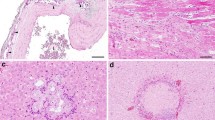Summary
This study applies to the agency of vitamin C on chemical carcinogenesis in the small intestine of rats. Administration of N-Ethyl-N′-nitro-N-nitrosoguanidine (ENNG) in drinking water produced tumors of the small intestine after 18 weeks in more than 90 %. The induction of tumors could not be suppressed by a large amount (2–3 %) of sodium ascorbate in food, but the depth of tumorinfiltation was restricted. Cancer developed in 29 of 36 rats receiving ENNG only. In 25 animals of this group growth of tumor corresponded to a P4 stage. In 24 of 35 animals, additionally receiving vitamin C, P4 stage was observed in only 13 cases. Pathological changes in the small intestine could not be observed after the sole administration of vitamin C.
Zusammenfassung
Die Studie gilt der Wirkung von Vitamin C auf die chemisch induzierte Dünndarmcarcinogenese der Ratte. Durch Verabreichung von N-Äthyl-N′-Nitro-N-Nitrosoguanidin (ÄNNG) im Trinkwasser (120 mg/l) wurden nach 18 Wochen bei über 90 % der Tiere Dünndarmtumoren erzeugt. Diese Tumorinduktion konnte durch die orale Verabreichung großer Mengen von Natriumascorbat im Futter (2g/100g Futter) nicht unterdrückt werden. Allerdings wird die Tiefeninfiltration der erzeugten Carcinome gehemmt. So haben 29 von 36 Ratten, die ausschließlich ÄNNG erhielten, ein Carcinom entwickelt. 25 Tiere (69%) dieser Gruppe wiesen ein Tumorstadium P4 auf. Hingegen wurde bei 24 von 35 Tieren, die zusätzlich Vitamin C erhielten ein Carcinom beobachtet, das aber nur bei 13 Tieren (37 %) das Tumorstadium P4 erreichte. Die alleinige Verabreichung von Vitamin C erzeugt keine Dünndarmveränderungen.
Similar content being viewed by others
Literatur
Benade L, Howard T, Burk D (1969) Synergistic killing of Ehrlich ascites carcinoma cells by ascorbate and 3-Amino-1,2,4,-triazole. Oncology 23:33–43
Cameron E, Pauling L (1973) Ascorbic acid and the glycosaminoglycans. An orthomolecular approach to cancer and other diseases. Oncology 27:181–192
Cameron E, Pauling L (1976) Supplemental ascorbate in the supportive treatment of cancer: Prolongation of survival times in terminal human cancer. Proc Natl Acad Sci 73:3685–3689
Cameron I, Grubbs B, Rogers W (1979) High-dose methylprednisolone, vitamin A, and vitamin C in rats bearing the rapidly growing Morris 7777 hepatoma. Cancer Treat Rep 63:477–483
Creagan E, Moertel C, O'Fallon J, Schutt A, O'Connell M, Rubin J, Frytak S (1979) Failure of highdose vitamin C (ascorbic acid) therapy to benefit patients with advanced cancer. N Engl J Med 301:687- 690
de Cosse J, Condon R, Adams M (1977) Surgical and medical measures in prevention of large bowel cancer. Cancer 40:2549–2552
Edgar J (1974) Ascorbic acid and biological alkylating agents. Nature 248:136–137
Frazier T, McGinn M (1979) The influence of magnesium, calcium and vitamin Con tumor growth in mice with breast cancer. J Surg Res 27:318–320
Ivankovic S, Zeller W, Schmähl D, Preussman R (1973) Verhinderung der pränatal carcinogenen Wirkung von Äthylharnstoff und Nitrit durch Ascorbinsäure. Naturwissenschaften 60:525
Mirvish S, Wallcave L, Eagen M, Shubik P (1972) Ascorbate-nitrite reaction: Possible means of blocking the formation of carcinogenic N-nitroso compounds. Science 177:65–68
Mirvish S (1975) Formation of N-nitroso compounds: chemistry, kinetics, and in vivo occurrence. Toxicol App] Pharmacol 31:325–351
Piontek G, Milner J, Cain C (1979) Metabolic effects of hyperthermia and ascorbic acid in Ehrlich ascites tumor cells. Proc Soc Exp Biol Med 160:69–73
Sander J (1971) Untersuchungen über die Entstehung kanzerogener Nitrosoverbindungen im Magen von Versuchstieren und ihre Bedeutung für den Menschen. (1.–3. Mitteilung) Arzneim Forsch (Drug Res) 21:1572–1580, 1707–1713, 2034–2039
Schlegel J (1975) Proposed uses of ascorbic acid in prevention of bladder carinoma. Ann NY Acad Sci 258:432–437
Schlegel J, Pipkin G, Nishimura R, Schultz G (1970) The role of ascorbic acid in the prevention of bladder tumor formation. J Urol 103:155–159
Schmähl D (1975) Zur kausalen Genese maligner Tumoren. Wien Med Wochenschr 125:637–642
Schmidt, F, Schmandke H, Gassmann B (1963) Vitamin C und Krebs. Z Ärztl Fortbild 57:1315–1324
Schneider E (1954) Vitamin C und A beim Carcinom. Ein Beitrag zur Hypervitaminisierungstherapie der Krebskranken. Dtsch Med Wochenschr 79:584–586
Varges A (1977) Nitrosamines look more like human cancer villains. JAMA 238:18–20
Yamafuji K, Nakamura Y, Omura H, Soeda T, Gyotoku K (1971) Antitumor potency of ascorbic, dehydroascorbic or 2,3-diketogulonic acid and their action on deoxyribonucleic acid. Z Krebsforsch 76:1- 7
Author information
Authors and Affiliations
Rights and permissions
About this article
Cite this article
Werner, B., Denzer, U., Mitschke, H. et al. Vitamin C und Dünndarmkrebs. Langenbecks Arch Chiv 354, 101–109 (1981). https://doi.org/10.1007/BF01271157
Received:
Issue Date:
DOI: https://doi.org/10.1007/BF01271157




